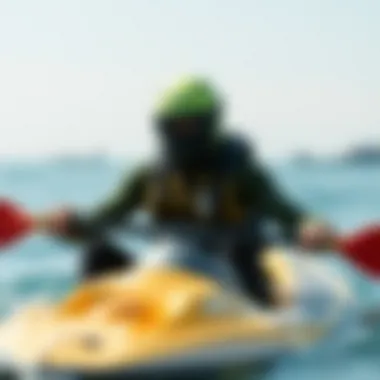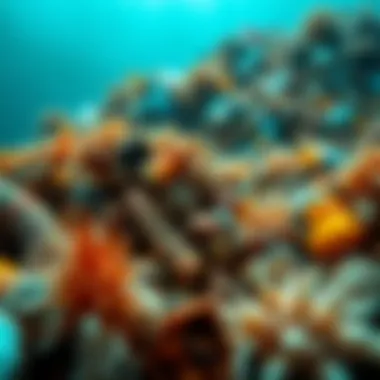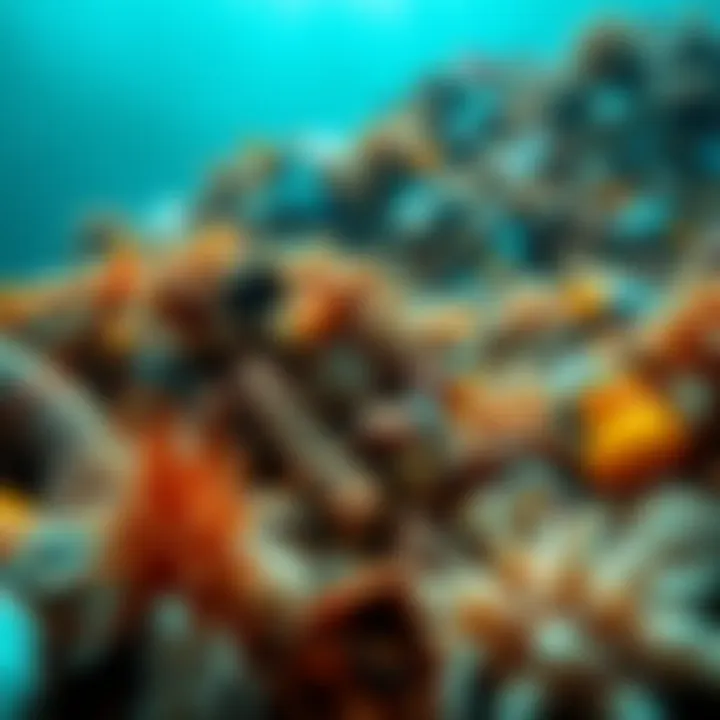Strategies for Reducing Plastic Waste in Watersports


Intro
As the ripple effects of plastic pollution become more evident, the watersport community finds itself at a pivotal crossroads. The beauty of the ocean beckons enthusiasts, yet beneath the glimmering surface lies a pressing issue: plastic waste. From the surfing beaches of California to the serene paddleboarding spots in Florida, the waterways and coastlines suffer as trash threatens marine ecosystems. The conversations surrounding sustainability are popping up more frequently, and for good reason. It's not just about enjoying the waves or the wind; it’s about preserving the environment that supports these beloved activities. This article delves into various practical strategies that can help mitigate the growing problem of plastic waste in watersports.
Whether you’re a seasoned surfer, a kitesurfing instructor, or just a paddleboarder looking to make a difference, understanding how to reduce plastic waste is essential. We’ll explore gear essentials that can minimize your ecological footprint, techniques that can be applied across different watersports, and tips for fostering a culture of sustainability in aquatic activities. By the end, you’ll walk away with a toolkit of ideas suitable for not just you but fellow enthusiasts who share your passions.
Understanding the Plastic Problem
In the world we live in today, plastic has become an integral part of our daily lives. Its sheer versatility makes it an ideal material for countless applications—from packaging to sporting gear. However, with its widespread use has come a hefty price: plastic pollution. Understanding the plastic problem is critical, especially for those involved in watersports. The implications extend beyond aesthetics, affecting marine ecosystems and, ultimately, our own health.
Historical Background of Plastic Use
The journey of plastic started in the early 20th century with the development of Bakelite, the first synthetic plastic. As time passed, the production of plastic surged, largely due to its low cost, durability, and lightweight properties. By the 1950s, plastic had woven itself into the fabric of modern society, dominating countless industries including transportation, electronics, and of course, sports equipment. Anyone who has paddled a kayak or stood on a paddleboard has likely encountered various plastic items designed for durability and performance. However, it wasn’t until the late 20th century that the negative consequences of plastic began to surface, notably in marine environments, causing environmental scholars and enthusiasts to take heed.
Scope of Plastic Pollution in Marine Environments
The oceans, covering over 70% of the Earth’s surface, are the final resting place for an estimated 8 million tons of plastic waste every year. Much of this material originates from urban runoff, littering, or improper waste disposal, often finding its way into our waters through rivers and streams. Once in the ocean, plastic takes centuries to decompose, breaking down into microplastics that are often consumed by marine life. This waste not only burdens the creatures that inhabit these waters but also poses risks to human health through the consumption of contaminated seafood. For those who love watersports, this presents a troubling reality.
The impact is far-reaching. According to a report from the United Nations, around 800 species globally are affected by plastic pollution, including seahorses and various fish species crucial to our ecosystem. Widening our scope of awareness on plastic pollution is vital, as it tangibly demonstrates how interconnected our actions on land affect our oceans.
Effects of Plastic on Aquatic Life
The effects of plastic on aquatic life are alarming. Animals often ingest plastic debris, mistaking it for food. This can lead to serious health problems, including malnutrition, intestinal blockages, and even death. Furthermore, chemicals found in plastics, such as bisphenol A and phthalates, can leach into the water. These substances disrupt endocrine systems of aquatic species, resulting in hormonal imbalances that can affect reproduction, growth, and behavior.
For example, seabirds like the albatross can ingest small plastic pieces, mistaking them for fish. Young fish are particularly vulnerable; consuming microplastics diminishes their chances of survival and success in later life stages. This not only impacts biodiversity but alters aquatic food webs, affecting not just the animals but also the humans who rely on these ecosystems for livelihood.
"Every piece of plastic ever made still exists in some form. It's not a problem we can ignore; we must address it at every level of engagement."
As watersport enthusiasts, acknowledging the plastic problem is not just about stewardship of the oceans—it's about safeguarding our enjoyment of these precious environments.
Understanding the broader impact of plastic pollution sets the stage for implementing effective strategies for change. Individuals and organizations alike can play a role in tackling this issue, fostering a new wave of sustainable practices in watersports that honor the ecology of the environments we cherish.
The Role of Watersports in Plastic Pollution
Understanding the role of watersports in plastic pollution is critical. It sheds light on how recreational activities contribute to the growing crisis of plastic waste in our oceans. As enthusiasts embark on watersports, they often overlook the footprints they leave behind. From kayaks to jet skis, the equipment we use and the waste we generate can significantly affect marine environments.
Common Sources of Plastic Waste in Watersports
When speaking of plastic waste stemming from watersports, several culprits come to mind. One of the foremost is the equipment itself. Many watersport enthusiasts do not realize that the gear they rely on often contains a myriad of plastic components, which may eventually find their way into the ocean. For instance, surfboards, paddleboards, and kayaks frequently incorporate plastic in their manufacturing process, leading to potential breakage and pollution.
Then there's the single-use plastic that's ever-present at events, like plastic bottles, food wrappers, and packaging materials for snacks. It’s quite common to see these items littered around beaches or onboard vessels. If you fish, you know that discarded fishing lines, hooks, and nets can ensnare marine life, or worse, contribute to microplastic pollution as they degrade.
A lesser-discussed issue is the accumulation of personal items—like sunscreen tubes and wet wipes—which, after using, many careless individuals toss aside. These bits of plastic might seem small, yet collectively they bear significant weight in the broader context of marine waste.
Case Studies: Watersports Events Impacting Plastic Pollution
To exemplify the impact of watersports on local environments, let’s delve into a few pivotal case studies. At a fictitious yet representative beachside festival in California, "Ocean Wave Fest," thousands flock to enjoy kiteboarding, stand-up paddleboarding, and beach volleyball. The event organizers set up vendors selling snacks in large plastic containers and bottled drinks. After the festival, the cleanup crews reported tons of waste—much of it plastic—was left behind. Despite efforts to recycle, many items, like food packaging, ended up in landfills instead of being processed responsibly.
On the other side of the globe, during the annual Hawaii International Surfing Competition, an alarming trend was noted. After surf sessions, competitors and spectators alike often left behind water bottles and snacks in plastic wrappings on the beaches, inadvertently contributing to the region’s growing waste problem. Groups advocating for cleaner oceans took it upon themselves to organize clean-up drives parallel to the events, shedding light on how participation in watersports can coincide with environmental responsibility.
These examples illustrate that watersports events can become double-edged swords. They foster community and enjoyment but also have the potential to exacerbate plastic pollution if waste management isn't prioritized.
Ultimately, recognizing these sources and impacts pushes the conversation toward actionable solutions. While enjoying our aquatic adventures, it is up to each individual to become stewards of the very environment that gives us joy.
Strategies for Individuals in Watersports
When it comes to tackling the issue of plastic waste in watersports, individuals hold a significant influence. Every choice made on the water can contribute to a larger environmental impact. Strategies for individuals in watersports focus on tangible actions that everyone from surfers to paddleboarders can take. Not only are these strategies vital for preserving marine ecosystems, but they can also set a precedent for others in the community, creating a ripple effect.
Opting for Eco-Friendly Equipment
Choosing Biodegradable Gear
Choosing biodegradable gear is a crucial step in the effort to reduce plastic consumption. Products made from natural materials break down more easily in the environment compared to their plastic counterparts. This quality sets biodegradable gear apart as it aligns with the eco-friendly goals of the watersports community. Imagine using a surfboard made from natural fibers rather than synthetic ones; once its life ends, it won’t sit in a landfill for a century.
However, a key characteristic of biodegradable gear is its initial cost. Often, these products require a more significant upfront investment. But, investing in such gear sends a clear message about sustainability and can encourage manufacturers to prioritize eco-friendly options. Over time, with increased demand, the cost may decrease as more brands begin to innovate in this direction.


Reusing and Repairing Equipment
The practice of reusing and repairing equipment stands as a vital strategy in reducing plastic waste. Many watersport enthusiasts tend to discard old gear when it shows signs of wear. Instead, fostering a culture of repair can substantially decrease the reliance on new products. It’s a bit like putting on a band-aid—you’re not just fixing a problem; you’re extending the life of something that still has usefulness.
One unique aspect of this approach is the creativity it sparks. From DIY fixes to upcycling projects, many paddlers have found innovative ways to breathe new life into their gear. It’s cost-effective, promotes creativity, and minimizes waste, highlighting its advantages as a sustainable practice. Yet, it does require some skill and effort, which can deter some individuals.
Implementing Waste Reduction Practices
Minimizing Single-Use Plastics
Minimizing single-use plastics is a straightforward yet powerful strategy. In the watersports community, single-use plastics are everywhere—from water bottles to snack wrappers. By consciously choosing reusable options, individuals can drastically lessen their plastic footprint. This shift from disposable to reusable items isn’t just environmentally friendly; it offers a practicality that makes sense, especially on longer outings.
By adopting this practice, watersport enthusiasts can become leaders in sustainable habits. The unique feature here is how easy it can be: simply switch out plastic bottles for stainless steel ones or tote around a cloth bag for snacks instead of single-use wrappers. While this may seem like a small change, as each person adapts, the collective impact can be substantial.
Encouraging BYOB (Bring Your Own Bottle)
Encouraging BYOB—Bring Your Own Bottle—could be a game-changer for watersport lovers. It promotes hydration without contributing to plastic waste. This simple practice can carry a huge message about sustainability; refraining from buying bottled water is like waving a flag for change. Plus, keeping a reusable bottle handy often means access to clean water at all times, which is vital during intense physical activities.
The uniqueness of this strategy lies in its community aspect. By promoting BYOB, individuals can inspire peers and local businesses to follow suit. The challenge, however, comes from habits rooted in convenience. Many might find it cumbersome to remember their bottles when heading out for fun. But with awareness and reminders, this habit can shift towards a more sustainable choice in the community.
Participating in Cleanup Initiatives
Organizing Local Beach Cleanups
Organizing local beach cleanups presents a powerful opportunity for watersport enthusiasts to take direct action against plastic waste. Not only do these events cleanse the shorelines of debris, but they also serve as a platform for community engagement. It’s about uniting like-minded individuals for a common cause, while making an immediate environmental impact. Getting your hands dirty together fosters camaraderie and environmental stewardship.
One of the standout benefits of beach cleanups is raising awareness—those who participate often become ambassadors for plastic reduction in their personal lives. Nonetheless, they do require organization and commitment, which may deter some. Yet the rewards, from cleaner beaches to strengthened community ties, often outweigh the initial effort.
Partnering with Environmental Organizations
Partnering with environmental organizations amplifies efforts in reducing plastic waste. By aligning with groups focused on marine conservation, watersports enthusiasts can tap into resources, knowledge, and public outreach strategies. This partnership can lead to joint initiatives like coastal cleanups or campaigns that educate the broader public on the importance of preserving marine environments.
The key advantage of this collaboration is leveraging expertise and networks. Not only does it provide individuals with advanced tools to tackle plastic waste, but it also enhances credibility. The challenge may lie in finding the right partners and establishing mutual goals. However, successful collaborations can yield exceptional results and foster a sense of shared responsibility.
To sum it up, individual actions in watersports can be mighty. By choosing eco-friendly equipment, minimizing waste, and looking for connections within the community, everyone can make a difference. Together, these strategies shape a more sustainable future for both the sport and the environment.
Advocating for Change in the Watersports Industry
Advocating for change in the watersports industry is crucial for addressing the escalating issue of plastic pollution. Watersports enthusiasts, from surfers to kiteboarders, often find themselves intimately connected to the oceans and waterways that are increasingly threatened by plastic waste. Shifting the tide requires collective action, which means calling upon industry leaders, local businesses, and individual participants to make concrete commitments to sustainability. By collaborating with key stakeholders and pushing for policy changes, the marine community can become a beacon of hope in the fight against plastic waste.
This is not just about saving the aesthetics of our oceans; it’s also about preserving marine ecosystems that are vital for biodiversity and human health.
Influencing Policy and Regulation
Engaging with Policymakers
Engaging with policymakers serves as one of the fundamental pillars for promoting change within the watersports sector. When watersport communities unite their voices, they can effectively advocate for legislation aimed at reducing plastic waste. It can be as simple as drafting letters or, on a larger scale, organizing rallies and public forums. The key characteristic of this engagement is that it cultivates awareness and drives the political agenda towards environmental sustainability.
Some might think that speaking to policymakers is a daunting task, but grassroots movements show that anyone can make their voices heard. In this sense, the collaborative efforts of watersport enthusiasts can push local governments to adopt more stringent regulations against single-use plastics. Additionally, when communities share their concerns with representatives, it reinforces the reality that a cleaner ocean is a priority for their constituents.
The unique aspect of engaging with policymakers is that it can lead to lasting change, fostering regulations that help manage plastic waste more effectively. However, it’s essential to recognize the challenges that can arise, such as bureaucratic resistance or a lack of immediate results. Yet, persistence and consistent advocacy can lead to significant victories.
Supporting Plastic Bans
Supporting plastic bans has emerged as a powerful approach to curtailing plastic waste in the oceans. The proposal to outlaw single-use plastics not only raises awareness of the pollution crisis but also articulates a clear message about the unacceptable impact of plastic on marine environments. This effort holds significant merit as it encourages both individuals and businesses to rethink their daily practices.
The primary characteristic of supporting plastic bans is its wide-ranging appeal; it addresses the core problem and holds businesses accountable. When bans are instituted, they often trigger a shift toward more sustainable alternatives and encourage innovation in product design. This conversation leads to greater environmental education, fostering a culture of responsibility among watersport participants.
The unique feature of this initiative lies in its potential to galvanize communities and create collective ownership over local environments. Yet, it’s important to recognize that not everyone might welcome such bans. Some business owners may argue about the economic impact, seeing a threat rather than an opportunity. Nevertheless, supporting plastic bans can act as a catalyst for broader societal change regarding consumption and waste.
Encouraging Sustainable Business Practices
Promoting Eco-Conscious Brands
Promoting eco-conscious brands is central to reducing plastic waste in the watersport industry. There is a growing market for sustainable products, and consumers are increasingly seeking brands that prioritize environmental responsibility. Highlighting these brands can encourage more businesses to adopt similar practices. This initiative not only helps consumers make informed decisions but also pressures less sustainable brands to adapt.


The key aspect here is that promoting eco-conscious brands contributes positively to both the environment and the economy. By supporting businesses that take sustainability seriously, participants in watersports can play an active role in shaping the market.
These brands often utilize sustainable materials and innovative designs, significantly minimizing their reliance on plastics. A challenge that arises is ensuring transparency and verifiability in claims made by brands; consumers need assurances that they are genuinely engaging with eco-friendly options. Yet, when this transparency is achieved, it serves as a powerful motivator for change.
Incentives for Businesses Reducing Plastic
Incentives for businesses reducing plastic serve as an effective strategy to motivate change within the industry. Financial programs, tax reductions, or grants for adopting sustainable practices can empower businesses to rethink their material choices. The merit of this approach lies in the potential for widespread compliance among businesses eager to improve their image while still maintaining profitability.
The distinctive feature of this strategy involves creating a positive feedback loop; as businesses reduce plastic use, they often discover that efficiency leads to cost savings, which can then be re-invested into further innovations.
However, it is critical to consider the limits of these incentives. Some smaller businesses may struggle with the initial investments required to switch to sustainable products. Yet, when such barriers are addressed through supportive policies and community engagement, it can lead to transformative changes in corporate behavior within the watersports industry.
Education and Awareness Programs
Education and awareness programs play a pivotal role in combating plastic waste in watersports. By equipping individuals with knowledge and resources, these programs foster a sense of responsibility toward the environment. Building awareness can lead to significant behavioral shifts, encouraging people—whether they be surfers, paddleboarders, or instructors—to reconsider their habits. In essence, raising awareness isn't just about informing; it's about inspiring action.
Incorporating Environmental Education into Watersports
Workshops and Training Sessions
Workshops and training sessions are not just gatherings; they serve as crucial platforms for sharing knowledge and practical skills about reducing plastic waste in watersports. Typically, these sessions bring together enthusiasts and experts alike, creating a dynamic learning environment. What sets workshops apart is their hands-on approach; participants often engage in activities that reinforce their understanding of sustainability and waste reduction techniques.
The main characteristic of these workshops is their interactivity, which can be much more effective than static presentations. They often feature demonstrations of eco-friendly gear and practices, making the learning experience tangible. This is a popular choice for individuals looking to enhance their understanding while enjoying time on the water.
On the flip side, while workshops can be incredibly engaging, they sometimes lack the reach of online platforms. They may cater to specific audience segments and might not always be accessible to everyone.
School Programs and Outreach
School programs and outreach initiatives extend the educational reach into younger demographics, ensuring that the next generation understands the importance of reducing plastic waste. These programs are often designed with creativity in mind, using engaging activities to capture students' attention. The unique selling point of these outreach efforts is their capacity to instill lifelong values early on, laying the groundwork for environmentally conscious behaviors that may stick with individuals as they grow.
One key advantage of school programs is the potential for widespread impact—reaching a large number of students can create a ripple effect within communities. However, a challenge lies in ensuring that the information shared is both accurate and actionable. Sometimes, schools may struggle with resource allocation, making it difficult to implement comprehensive programs.
Utilizing Social Media for Awareness
In today's digital landscape, social media emerges as a powerful tool for raising awareness about plastic waste in watersports. Harnessing platforms like Facebook, Instagram, and TikTok enables content creators to reach vast audiences while sharing critical messages about sustainability. Social media can quickly amplify calls to action, mobilizing communities around collective efforts to reduce plastic pollution.
Creating Engaging Content
Creating engaging content is crucial in capturing the attention of an audience saturated with information. The key characteristic here lies in storytelling; using narratives that resonate with the audience can transform statistics into compelling stories. Short videos, visual infographics, and interactive posts encourage user interaction, further spreading the message.
This approach is effective because it mirrors modern communication styles that young people favor. Nevertheless, creating truly engaging content demands a continuous effort to innovate and adapt to changing trends, which can be time-consuming.
Highlighting Success Stories
Highlighting success stories can inspire change and demonstrate tangible impacts of reduced plastic waste. By sharing the achievements of individuals or organizations, motivations can be ignited among those who might feel disheartened by the scale of the problem. Broadcasting these stories on standard platforms often provides a sense of community, reinforcing the notion that collective action can yield significant gains.
One unique feature of success stories is their ability to motivate others through relatability. The downside is that sometimes, these narratives can come off as isolated instances if not positioned within a broader context. Regularly sharing diverse examples is essential to ensure individuals don't misconstrue small wins as the only solutions.
"We cannot solve our problems with the same thinking we used when we created them.” – Albert Einstein
The combination of educational programs, social media campaigns, and creativity will create a comprehensive approach to awareness that contributes significantly to reducing plastic waste in watersports. By focusing on merging practical information with inspiring stories, communities can work together toward a more sustainable future.
Innovative Alternatives to Plastic
As the tide turns against plastic pollution, exploring innovative alternatives becomes paramount within the context of watersports. The challenge is not just to find substitutes, but to foster a sustainable ethos that resonates with both enthusiasts and environmental advocates. This shift is not mere fantasy; it represents a significant stride towards reducing our ecological footprint while enjoying our time on the water. From biodegradable materials to advanced recycling technologies, each alternative offers a hunting ground for new possibilities and solutions.
Exploring Biodegradable and Sustainable Materials
Natural Fibers in Equipment
Natural fibers such as hemp, jute, and bamboo are gaining traction as sustainable options in watersports gear. The key characteristic of these materials is their ability to decompose naturally over time, which cuts down on long-term waste in marine environments. For instance, hemp is known for its strength and resilience, making it a favorite choice for ropes and sails in sailing and kayaking. Their biodegradable nature makes them a popular choice among eco-conscious sailors and paddleboarders alike.
Natural fibers stand out due to their low environmental impact during cultivation compared to synthetic fibers. They often require less water and no chemical fertilizers, reducing the load on ecosystems. However, there can be challenges. For example, while these materials break down, they may not always perform as well as traditional, synthetic options under heavy use.
Plant-Based Packaging Options


Plant-based packaging serves as another promising alternative in the battle against plastic waste. Made from materials like corn starch or sugarcane, these options are designed to be compostable, thus diminishing the waste sent to landfill. The ability to break down into natural elements within a short timeframe is a key factor in promoting the use of such packaging in gear production.
A unique feature of plant-based packaging is that it originates from renewable resources, contributing to a more sustainable cycle of production and consumption. Several companies are adopting these materials for packaging products such as surfboard accessories and bottled water, which are frequently used in watersport activities. Nevertheless, they can have some disadvantages, including potentially higher costs and the need for industrial composting facilities for proper disposal.
Advancements in Recycling Technologies
Enhanced Recycling Processes for Marine Gear
Recycling technologies for marine gear have seen notable advancements, particularly with the goal of reprocessing discarded equipment effectively. Enhanced recycling processes involve breaking down materials to their base elements, allowing manufacturers to create new products without reliance on virgin resources. The key characteristic of these processes is the ability to recover valuable materials from end-of-life products, setting the stage for a circular economy in the watersports industry.
These technologies illustrate a beneficial transition for both the environment and the economy. By reducing the need for new materials, manufacturers can save costs and lessen their carbon footprint. Nonetheless, the infrastructure for such recycling practices is still developing within many locales, posing challenges to widespread adoption.
Collaboration with Circular Economy Initiatives
Collaborating with circular economy initiatives can amplify efforts to minimize plastic waste in watersports. These initiatives often focus on creating a closed-loop system where waste materials are continuously repurposed into new products. The key trait of this collaboration is the pooling of resources and knowledge among different stakeholders in the industry, including manufacturers, retailers, and environmental organizations.
Working together on these initiatives enables the sharing of best practices and the development of new technologies, which can lead to more sustainable product life cycles. While promising, this approach can also have its pitfalls, such as the need for initial financial investment and coordination among diverse groups. Despite this, the potential to reshape the watersports supply chain makes it a worthy venture to pursue.
Community Engagement and Collaboration
Community engagement plays a pivotal role in reducing plastic waste in watersports. It not only amplifies awareness around the environmental issues that are plaguing our oceans, but it also empowers individuals and groups to take tangible actions that can lead to significant change. Bringing together local communities fosters a collective responsibility towards marine conservation, creating a strong network of support that can effectively combat the rampant plastic pollution that threatens aquatic ecosystems.
The benefits of community collaboration extend beyond mere environmental gains. By working together, communities can develop a shared sense of purpose, which deepens ties among members. This kind of collective engagement can provide opportunities for education and experience sharing, which ultimately instills a more profound understanding of sustainability within watersports. Furthermore, initiatives led by community members often garner more interest and participation than top-down efforts, highlighting the importance of inclusive involvement in this endeavor.
Building Alliances with Local Communities
Creating alliances with local communities is essential for tackling plastic pollution effectively. When watersports enthusiasts—whether they be surfers, paddleboarders, or kitesurfers—align with local environmental organizations and community groups, the effort to reduce plastic waste becomes more focused and impactful. These partnerships can lead to joint projects, such as community clean-up events, educational workshops, and beach restoration initiatives.
One effective approach to building alliances is to hold introductory meetings or forums that inform and inspire community members regarding the scale of plastic pollution. For example, hosting a beach cleanup could serve both as a practical measure against litter and a gathering point for discussions about long-term solutions, ranging from advocating for legislative changes to exploring alternative materials in watersport gear. Utilizing local media platforms, such as community newsletters or social media groups, can also help spread the word and encourage participation.
Additionally, community alliances can also pave the way for shared resources. Watersports organizations and local businesses can collaborate to host events or supply eco-friendly products, effectively pooling their expertise and capabilities to drive the cause further. By doing so, they can create a more resilient network that supports each other’s efforts to minimize plastic usage and enhance sustainable practices.
Encouraging Group Initiatives and Challenges
Group initiatives and challenges can significantly boost community efforts to reduce plastic waste in watersports. Engaging local athletes, groups, and organizations through exciting challenges cultivates a sense of camaraderie and friendly competition, encouraging widespread participation.
Consider organizing a "Plastic-Free Challenge," where participants commit to using no single-use plastics during local watersports events for a designated period. This not only raises awareness but also helps individuals discover practical alternatives to plastic. Accountability is key here; sharing progress on social media or through community platforms can motivate participants and track collective achievements.
Moreover, encouraging local businesses to join these initiatives can synergize efforts. Local gear shops might offer discounts for those who complete the challenge or showcase eco-friendly products during events. This creates a win-win situation, where businesses gain visibility while consumers are provided with the means to make better choices.
In essence, fostering community engagement through alliance-building and group initiatives cultivates a foundation for meaningful change. Together, local members can become advocates for ecological responsibility while promoting sustainable practices within the realm of watersports.
"We don’t just inherit the planet from our ancestors; we borrow it from future generations."
— An ancient saying that rings true in the context of our responsibility towards plastic waste.
Future Perspectives on Plastic Reduction in Watersports
Addressing plastic waste in watersports is more important now than ever. As the popularity of these activities continues to grow, so does the strain on our oceans and waterways. If nothing changes, we could be staring down a tide of irreversible damage to marine ecosystems. In this section, we'll discuss how looking ahead can shape our approach to sustainability in watersports.
The future of plastic reduction hinges on various elements, spanning from technological innovations to changes in consumer behavior. Understanding these dynamics is pivotal. For instance, the move toward biodegradable and sustainable materials is not just a fad. It’s becoming a standard expectation in the industry, setting the stage for an innovative resurgence in how watersports equipment is made. The emphasis on sustainability opens doors to materials that not only lessen environmental impact but are also often more durable and effective.
Key Benefits of Focusing on the Future:
- Informed Consumer Choices: Today’s consumers are increasingly aware of the issues surrounding plastic waste. By aligning future practices with these concerns, businesses can enhance their marketability.
- Regulatory Support: Governments are starting to step up enforcement against plastic waste. Those industries willing to adapt may benefit from supportive policies and potential subsidies.
- Long-term Viability: Sustainable practices are not about short-term gains. Instead they're about ensuring that future generations can enjoy watersports without detrimental effects on ocean health.
The discussions around these perspectives are essential, as they help frame major upcoming shifts. As we move forward, we must consider how advancements are intertwined with collective responsibility, emphasizing that each small effort contributes to a larger goal. Without action, the phrase "out of sight, out of mind" will lead to dire consequences.
Emerging Trends in Sustainable Practices
Watersports enthusiasts and businesses are becoming actively engaged in emerging trends aimed at reducing plastic. These practices are not only innovative but also effective in minimizing waste.
- Eco-Conscious Material Development: New materials such as hemp, recycled plastics, and even mycelium are making waves.
- Product Lifecyle Considerations: Manufacturers are increasingly focusing on the entire lifecycle of a product, from its creation to its end of life. This involves designing products that can be easily repaired or recycled.
- Educational Programs: There’s a push for better education and training in the industry. By fostering a community of informed participants, the likelihood of adopting sustainable practices increases.
"The journey towards sustainable watersports requires each one of us to make adjustments that may seem small, yet collectively they lead to monumental impacts."
Potential Impact of Policy Changes
With governments responding to the plastic crisis, policies are evolving rapidly. This has several key implications for the watersports realm:
- Stricter Regulations on Plastic Usage: As policies tighten regarding single-use plastics, manufacturers will need to innovate quickly to comply while still delivering quality products.
- Support for Sustainable Initiatives: Various governments are now offering grants and funding for projects focused on sustainability. Engaging in these programs can lead to a significant boost in local watersports communities.
- Rewards for Responsible Companies: Companies that demonstrate environmentally friendly practices may receive tax breaks or public recognition. This can make a substantial difference in competitive industries where image matters.
As a flood of change sweeps through regulations and practices aimed at reducing plastic waste, the links between responsible actions and positive outcomes will become increasingly clear. Engagement in policy discussions will be essential, as this is where many of the rules of the game are decided.



